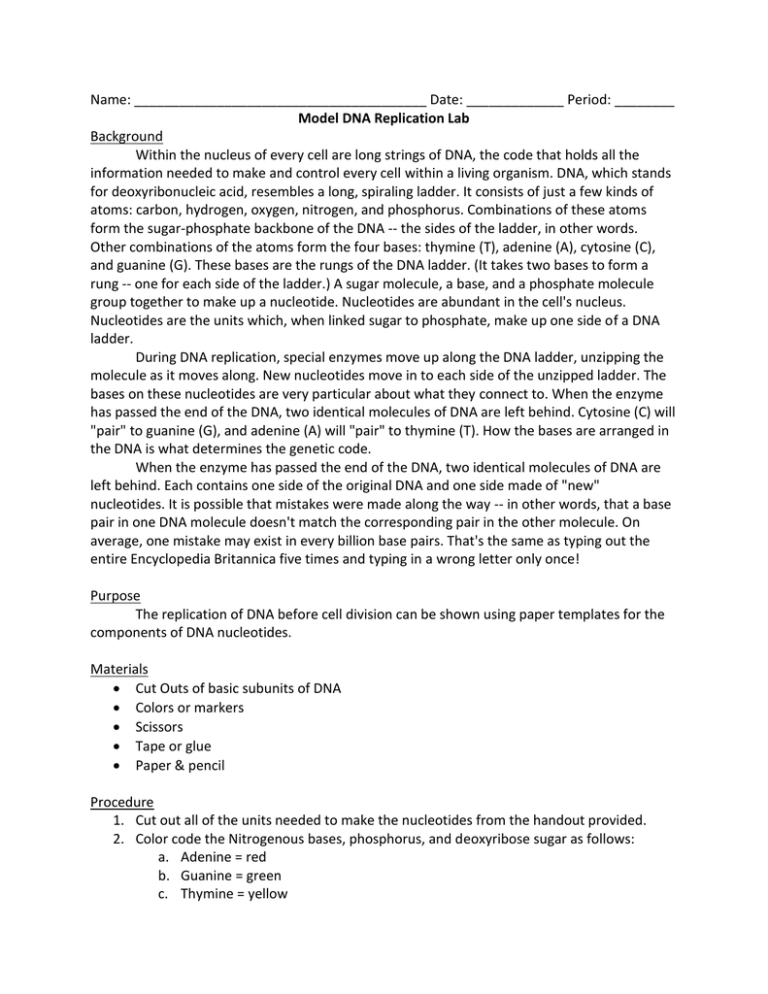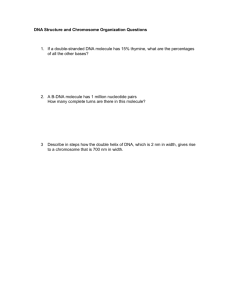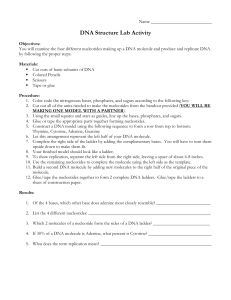Name: Date: ______ Period: ______ Model DNA Replication Lab
advertisement

Name: _______________________________________ Date: _____________ Period: ________ Model DNA Replication Lab Background Within the nucleus of every cell are long strings of DNA, the code that holds all the information needed to make and control every cell within a living organism. DNA, which stands for deoxyribonucleic acid, resembles a long, spiraling ladder. It consists of just a few kinds of atoms: carbon, hydrogen, oxygen, nitrogen, and phosphorus. Combinations of these atoms form the sugar-phosphate backbone of the DNA -- the sides of the ladder, in other words. Other combinations of the atoms form the four bases: thymine (T), adenine (A), cytosine (C), and guanine (G). These bases are the rungs of the DNA ladder. (It takes two bases to form a rung -- one for each side of the ladder.) A sugar molecule, a base, and a phosphate molecule group together to make up a nucleotide. Nucleotides are abundant in the cell's nucleus. Nucleotides are the units which, when linked sugar to phosphate, make up one side of a DNA ladder. During DNA replication, special enzymes move up along the DNA ladder, unzipping the molecule as it moves along. New nucleotides move in to each side of the unzipped ladder. The bases on these nucleotides are very particular about what they connect to. When the enzyme has passed the end of the DNA, two identical molecules of DNA are left behind. Cytosine (C) will "pair" to guanine (G), and adenine (A) will "pair" to thymine (T). How the bases are arranged in the DNA is what determines the genetic code. When the enzyme has passed the end of the DNA, two identical molecules of DNA are left behind. Each contains one side of the original DNA and one side made of "new" nucleotides. It is possible that mistakes were made along the way -- in other words, that a base pair in one DNA molecule doesn't match the corresponding pair in the other molecule. On average, one mistake may exist in every billion base pairs. That's the same as typing out the entire Encyclopedia Britannica five times and typing in a wrong letter only once! Purpose The replication of DNA before cell division can be shown using paper templates for the components of DNA nucleotides. Materials Cut Outs of basic subunits of DNA Colors or markers Scissors Tape or glue Paper & pencil Procedure 1. Cut out all of the units needed to make the nucleotides from the handout provided. 2. Color code the Nitrogenous bases, phosphorus, and deoxyribose sugar as follows: a. Adenine = red b. Guanine = green c. Thymine = yellow d. Cytosine = blue e. Phosphate = brown f. Deoxyribose = purple. 3. Using the small squares and stars as guides, line up the bases, phosphates and sugars. 4. Now glue the appropriate parts together forming nucleotides. 5. Construct DNA model using the following sequence to form a row from top to bottom cytosine (topmost), thymine, guanine, and adenine (bottommost). 6. Let this arrangement represent the left half of your DNA molecule. 7. Complete the right side of the ladder by adding the complementary bases. You will have to turn them upside down in order to make them fit. 8. Your finished model should look like a ladder. 9. To show replication, separate the left side from the right side, leaving a space of about 6-8 inches. 10. Use the remaining nucleotides to complete the molecule using the left side as the base. 11. Build a second DNA model by adding new nucleotides to the right half of the original piece of the molecule. 12. Tape the nucleotides together to form 2 complete DNA ladders. 13. Attach to the results section of this lab handout Results Analysis 1. Of the 4 bases, which other base does adenine most closely resemble? 2. List the 4 different nucleotides. 3. Which 2 molecules of a nucleotide form the sides of a DNA ladder? 4. If 30% of a DNA molecule is Adenine, what percent is Cytosine? 5. What does the term replication mean? 6. What is another name for adenine and three phosphate molecules attached to it?







